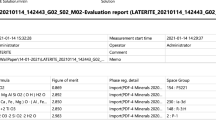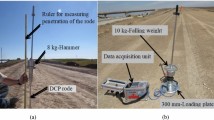Abstract
Quarry dust is a waste material which could pose as a serious environmental risk factor, which requires proper handling for safety. Also to harness locally available materials, lateritic soil and quarry dust have been an attractive proposition. This work studied 0–180 min at 30 min intervals of elapsed time between mixing operation and compaction for lateritic soil treated with lime and quarry dust. Constant dosages of lime 2, 4, 6 and 8% were mixed with variations of quarry dust of 3, 6, 9, 12, 15 and 18%; all percentages were measured by weight of the dry lateritic soil. Preliminary tests were conducted on the natural lateritic soil for characterization. The clay minerals present in the lateritic soil were identified using X-ray diffraction technique while the mineral oxide composition of quarry dust was done using X-ray fluorescent technique. The tests carried out on the treated lateritic soil were compaction test (British Standard Light), California Bearing Ratio (CBR) and unconfined compressive strength (UCS). The lateritic soil was classified to be A-6 (3) in the AASHTO rating system and Clayey Sand (SC) in the Unified Soil Classification System. The predominant non-clay mineral and clay mineral present in the soil were quartz and kaolinite, respectively, with traces of Moganite, Gismondine, Sanidine, Muscovite and Dickite. The quarry dust was found to satisfy the requirements for good pozzolanic materials. The Atterberg limits for the treated lateritic soil all reduced with increase in lime and quarry dust contents. The compaction and strength characteristics of the treated lateritic soil all reduced with increase in elapsed time between mixing and compaction. The California bearing ratio and the unconfined compressive strength at 7 days of curing period increased by 230.77% and 126.61%, respectively, at the addition of up to 8% of lime and 18% of quarry dust contents. A predictive model of good fit was developed for maximum allowable time elapsed between mixing operation and compaction for any given mix and strength characteristics. The correlation coefficient “R” and coefficient of determination “R2” are 0.902 and 0.814, respectively. Also at 95% confidence level, lime content, quarry dust content, optimum moisture content (OMC), California bearing ratio (CBR) and unconfined compressive strength (UCS) all affected the elapsed time between mixing and compaction significantly.




Similar content being viewed by others
Abbreviations
- D:
-
Compaction delay (minutes)
- L:
-
Lime content (%)
- Q:
-
Quarry dust content (%)
- C:
-
California bearing ratio (%)
- M:
-
Optimum moisture content (%)
- S:
-
Unconfined compressive strength at 7 days of curing period (KN/m2)
References
Amadi, A. A., & Eberemu, O. A. (2013). Potential application of lateritic soil stabilized with cement kiln dust (CKD) as liner in waste containment structures. Geotech Geol Eng, Springer, 31(4), 1221–1230. https://doi.org/10.1007/s10706-013-9645-3
Eberemu, O. A. (2013). Evaluation of bagasse ash treated lateritic soil as a potential barrier material in waste containment. Acta Geotechnica, Springer, 8(4), 407–421. https://doi.org/10.1007/s11440-012-0204-5
Etim, R. K., Attah, I. C., Eberemu, A. O., & Yohanna, P. (2019). Compaction behaviour of periwinkle shell ash treated lateritic soil for use as road sub-base construction material. Journal of Geoengineering, 14(3), 179–190. https://doi.org/10.6310/jog.201909_14(3).6
Etim, R. K., Attah, I. C., & Yohanna, P. (2020). Experimental study on potential of oyster shell ash in structural strength improvement of lateritic soil for road construction. Int J Pavement Res Technol, 13(4), 341–351. https://doi.org/10.1007/s42947-020-0290-y
Okonkwo, U. N. (2017). Lateritic soil and calcined kaolin for earth embankments. J Environ Geotech, Proc Inst Civil Eng, United Kingdom, 4(6), 1–6. https://doi.org/10.1680/jenge.16.00011
Okonkwo, U. N. (2019). Critical state of compacted lateritic soil and palm kernel shells ash for earth embankments. Ground Improvement, Proceedings of Institution of Civil Engineers. https://doi.org/10.1680/jgrim.19.00005
Okonkwo, U. N., & Agunwamba, J. C. (2014). Characterization of bagasse ash and lateritic soil for low-cost road construction in Nigeria. Nigerian J Soil Environ Res, 12, 154–159.
Okonkwo, U. N., Arinze, E. E., & Ugwu, E. I. (2018). Lateritic soil treated with polyvinyl and waste powder as a potential material for liners and cover in waste containment. J Solid Waste Manag, 44(2), 173–179.
Oluremi, J. R., Yohanna, P., Ishola, K., Yisa, G. L., Eberemu, A. O., Ijimdiya, S. T., & Osinubi, K. J. (2017). Plasticity of Nigerian lateritic soil admixed with selected admixtures. Environ Geotech, Proc Inst Civil Eng, United Kingdom, 6(3), 137–145. https://doi.org/10.1680/jenge.15.00085
Oluremi, J. R., Ijimidiya, S. T., Eberemu, O. A., & Osinubi, K. J. (2019). Reliability evaluation of hydraulic conductivity characteristics of waste wood ash treated lateritic soil. Geotech Geol Eng, Springer, 37(2), 533–547. https://doi.org/10.1007/s10706-018-0625-5
Onakunle, O., Omole, D. O., & Ogbiye, A. S. (2019). Stabilization of lateritic soil from Agbara Nigeria with ceramic waste dust. Cogent Eng Taylor Francis, 6(1), 1–10. https://doi.org/10.1080/23311916.2019.1710087
Osinubi, K. J., Eberemu, O. A., Ijimidiya, T. S., Sani, J. E., & Yakubu, S. E. (2018). Volumetric shrinkage of compacted lateritic soil treated with bacillus pumilus (pp. 315–324). Conference Proceedings, GeoShanghai International Conference.
Das, B., & Gattu, M. (2018). Study of “Performance of quarry dust as fine aggregate in concrete” conference proceedings. International Conference on Advances in Construction Materials and Structures.
Febin, Gk., Abrahamani, A., Vineetha, A. K., Manisha, V., Ramkrishnan, R., Sathyan, D., & Mini, K. M. (2019). Strength and durability properties of quarry dust powder incorporated concrete blocks (Vol. 228). Construction and Building Materials, Elsevier. https://doi.org/10.1016/j.conbuildmat.2019.11679
Jannah, N., Hamid, A., Kadir, A. A., Kamil, N. A. F. M., & Hassan, M. I. H. (2018). Overview of the utilization of quarry dust as a replacement material in construction industry. Penerbit UTHM, Universiti Tun Hussein Onn Malaysia, 10(2), 112–117. https://doi.org/10.30880/ijie.2018.10.02.021
Kadir, A. A., Hassan, M. I. H., Sarani, N. A., Abdul Rahim, A. S., & Ismail, N. (2017). Physical and mechanical properties of quarry dust waste incorporated into fired clay brick. AIP Conference Proceedings. https://doi.org/10.1063/1.4981862
Meisuh, B. K., Kankam, C. K., & Buabin, T. K. (2018). Effect of quarry rock dust on the flexural strength of concrete. Case Stud Constr Mater, Elsevier, 8, 16–22. https://doi.org/10.1016/j.cscm.2017.12.002
Okonkwo, U. N. (2009). Effects of compaction delay on properties of cement-bound lateritic soils. Nigerian Journal of Technology, 28(2), 5–12. ISSN: 0331-8443.
Quadri, H. A., Adeyemi, O. A., & Bobzom, B. G. (2013). Impact of compaction delay on engineering properties of cement treated soil. IOSR J Mech Civil Eng (IOSR-JMCE), 4(6), 9–15. ISSN: 2278-1684.
Sherwood, P. T. (1993). Soil stabilization with cement and lime: a state-of-the-art review. Department of Transport, Transport Research Laboratory.
Osinubi, K. J., & Nwaiwu, C. M. O. (2006). Compaction delay effects on properties of lime treated soil. J Mater Civil Eng Am Soc Civil Eng, 18(2), 250–258. https://doi.org/10.1061/(ASCE)0899-1561(2006)18:2(250)
Jin, R. (2020). Multivariate regression models for predicting compressive strength of bone ash stabilized lateritic soil for sustainable building. Construction and Building Materials, 263, 120677. https://doi.org/10.1016/j.conbuildmat.2020.120677
Ochepo, J., & Yusuf, A. (2019). Predicting the unconfined compressive strength of laterite-cementt mixture obtained from Zaria at different water-cement ratio. ABUAD J Eng Res Dev, 2(2), 95–101.
Okonkwo, U. N., Agunwamba, J. C., & Iro, U. I. (2016). Geometric models for lateritic soil stabilized with cement bagasse ash. Nigerian Journal of Technology, 35(4), 769–777. https://doi.org/10.4314/njt.v35i4.11
Onyelowe, K. C., & Van, D. B. (2018). Predicting strength behaviour of stabilized lateritic soil-ash matrix using regression model for hydraulically bound materials purposes. Int J Pavement Res Technol. https://doi.org/10.1016/j.ijprt.2018.08.004
ASTM. (2015). D4318–10: “Standard test methods for labouratory consistency limits tests.” American Society for Testing and Materials International.
ASTM. (2017). D6913/D6913-17: “Standard test methods for particle-size distribution (gradation) of soils using sieve analysis.” American Society for Testing and Materials, International.
BSI 1377. (2016). Methods of test for soils for civil engineering purposes: general requirements and sample preparation. British Standard Institute.
BSI 1924. (1990). Methods of test for stabilized soils. British Standard Institute.
Nigerian General Specification. (1997). Bridges and Roadworks (Vol. 11). Federal Ministry of Works.
Corporation, I. B. M. (2011). SPSS statistics. International Business Machines Corporation.
AASHTO. (1986). Standard specifications for transportation, materials and methods of sampling and testing. American Association of State Highway and Transportation Officials.
ASTM. (2017). D2487: “Standard practice for classification of soils for engineering purposes (Unified Soil Classification System).” American Society for Testing and Materials International.
Hurbult, C. S. (1957). Dana’s manual mineralogy (16th ed.). John Wiley and Sons.
Mitchel, J. K., & Soga, K. (2005). Fundamentals of soil behaviour (3rd ed.). Wiley.
ASTM. (2001). C618: “Standard specification for coal fly ash and raw or calcined natural pozzolana for use as mineral admixture.” American Society for Testing and Materials, International.
Al-Rawas, A. A., Hago, A. W., & Al-Sarmi, H. (2005). Effect of lime, cement and sarooj (artificial pozzolan) on the swelling potential of an expansive soil from Oman. Build Environ Sci Direct, 40(5), 681–687. https://doi.org/10.1016/j.buildenv.2004.08.028
Attoh-Okine, N. O. (1995). Lime treatment of laterite soils and gravels-revisited. Constr Build Mater Sci Direct, 9(5), 283–287. https://doi.org/10.1016/0950-0618(95)00030-j
Author information
Authors and Affiliations
Corresponding author
Supplementary Information
Below is the link to the electronic supplementary material.
Rights and permissions
About this article
Cite this article
Okonkwo, U.N., Arinze, E.E. & Ubochi, S.U. Predictive Model for Elapsed Time Between Mixing Operation and Compaction of Lateritic Soil Treated with Lime and Quarry Dust for Sub-base of Low-cost Roads. Int. J. Pavement Res. Technol. 15, 243–255 (2022). https://doi.org/10.1007/s42947-021-00022-4
Received:
Revised:
Accepted:
Published:
Issue Date:
DOI: https://doi.org/10.1007/s42947-021-00022-4




